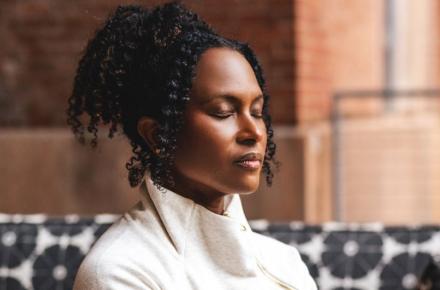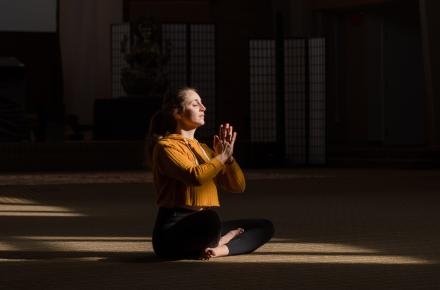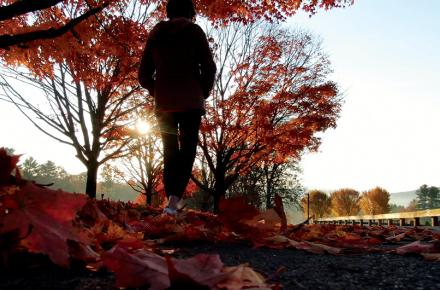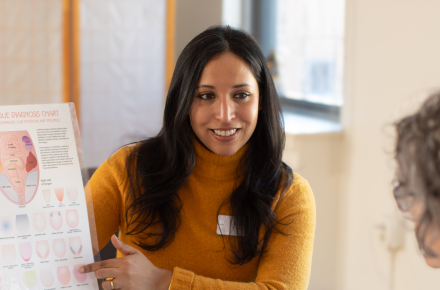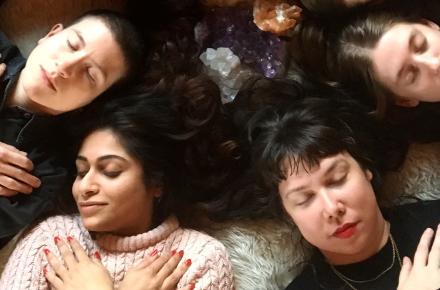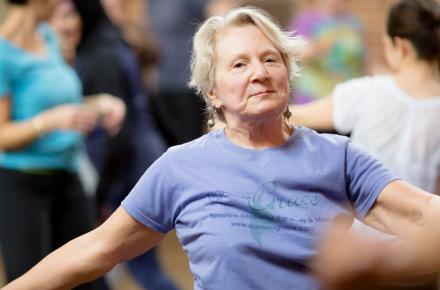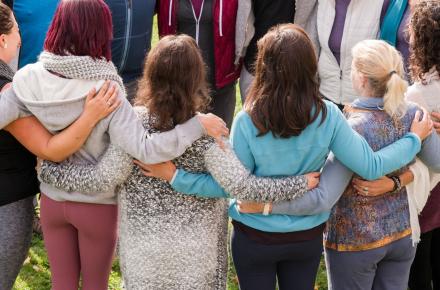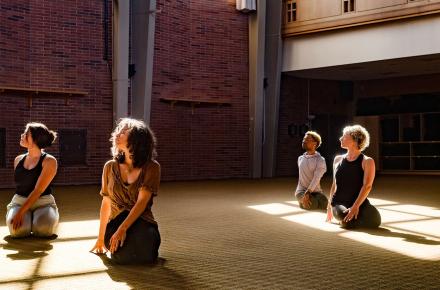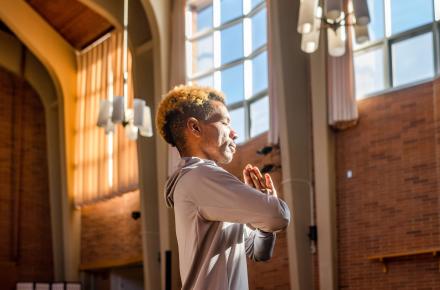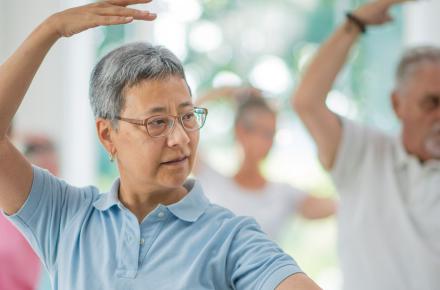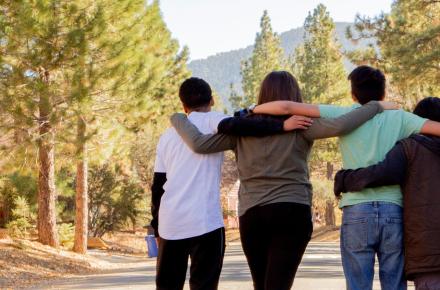The Yoga of Feelings: Gaining Self-Acceptance, Losing Weight

by Lisa Groshong
In this piece, Kripalu Yoga teacher Lisa Groshong shares how the simple and compassionate act of paying attention eventually allowed her to shed pounds—and feelings—she’d carried with her for years.
Practicing yoga helped me learn how to feel. Learning to feel helped me lose more than 50 pounds.
I have spent much of my life in my head, which I always thought was a safe place to hide. Along with my practice in thinking and analyzing, I’ve had plenty of practice in feeling bad about being fat. I’ve known all about the frustration of trying to button a waistband around a thick middle, of sitting on my hands so I wouldn’t grab an extra slice of pizza, of hoping the stranger sitting next to me on the airplane wouldn’t notice my butt crowding against the armrest.
I remember being horrified when, against my protests, a tiny little yoga teacher insisted on hoisting me into a handstand I was not strong enough to maintain. As she struggled to hold my flailing tree-trunk legs aloft, the baggy T-shirt I had worn as camouflage fell down over my head, exposing rolls of fat to the entire class.
Even though I knew plenty about my emotional body and the rollercoaster ride that feelings can be, I had no idea how to inhabit my physical body. Considering the body I lived in, it’s no surprise that I’d choose my mind over my body. But yoga helped me change that.
I became a yoga teacher by accident, after a friend called me to fill in when the leader of the class in her church auditorium quit. I called upon what I had learned during Kripalu’s Volunteer Program to cobble together a session. I discovered in that first class that I loved teaching—so much that I attended Kripalu Yoga Teacher Training soon afterward, soldiering through the nagging feeling that someone as obviously lacking in willpower and physical aptitude as myself had no right to become a yoga teacher.
When I moved back to my Missouri hometown, I started teaching a class at the recreation center and slowly built a community of dedicated students. I think my size helped put my yoga-phobic students at ease. Maybe they thought I was less likely to criticize them, that my acceptance and approval in my classes was wide and all-inclusive, that I wasn’t going to ask them to tie their legs in a knot.
My size gave me empathy for my students, mostly beginners, mostly stiff, some old, some overweight. Like them, I struggled. While I could now touch my toes, I still understood exactly how difficult the physical practice of yoga could be.
I wanted my students to feel confident in their postures, so I worked hard to explain alignment and help them key into sensations they could expect to feel. Of course, this meant I had to know what to tell them. While leading postures, I began to look inside to find sensations and ways to articulate them. I invited my students to focus on the physical feelings in their feet as we spread our toes wide in Tadasana. As I talked my students through Spinal Twist, I’d notice my own rib cage, the tendons stretching under my armpit, the elasticity of the skin around my neck.
Teaching several classes a week was a huge leap from my personal practice, which, to be honest, had always been a little flimsy. As a teacher, I was doing enough yoga to see the incremental loosening that comes from practicing every day.
When I became able to flatten my palms on the floor in a standing forward fold, I felt proud, and that I had proven my ability to register success, however small, in yoga. Small successes in my practice helped me soften towards myself, helped me believe that even though my body was still, in my opinion, profoundly flawed, I could still be a yogi and a competent, maybe even gifted, yoga teacher. Having spent my life as a gawky, clumsy, unathletic person, this internal shift was no small feat.
I began to understand and accept the responsibility I had to myself and my students to embody the principles of Kripalu Yoga: recognizing that each of our bodies is different from every other and has its own unique needs, limitations, and strengths; that the physical practice of yoga is in the service of self-transformation; and that what we practice on the mat can go with us into our daily lives.
As a result, I was able to simply observe, becoming more aware of the way my belly squished and got in my way during forward bends, and my thick thighs kept my toes from tucking behind my calf in Eagle. But my legs were getting stronger in Warriors, and my arms had stopped wobbling in One-Armed Plank. For moments at a time, I could simply observe myself without placing qualitative judgment on what I was doing or how I was doing it. Without realizing it, I had begun to practice the asana of self-compassion.
Empowered by my yoga practice, I embarked on my first true diet, the kind with no white bread, no sweets, nothing fried. As I shed pounds, I also shed the harmful ways in which I saw my body. Accepting myself was an asana I had to practice all day long—and it was a lot more tricky than that handstand had been.
Instead of seeing myself as a hulking monstrosity, I began to appreciate the joys my body had to offer. I allowed myself to indulge in the pleasures of a deep stretch, which I discovered can be just as delicious as a spoonful of Ben & Jerry’s. I signed up for swimming lessons and learned that once I stopped swallowing water, I loved the blue serenity of the pool and the rush that came from swimming lap after lap. I gave the elliptical machines outside the yoga studio a whirl and found a deep sense of satisfaction when sweat poured down my arms and legs.
The next step in learning to feel was learning how to taste food. I remember as a girl standing before a glass bakery cabinet and the woman at the counter handing me my favorite: a powdered-sugar-dusted cream horn, a crispy pastry I couldn’t wait to devour.
On my new journey toward being more present in my body, the cream horns I had always loved had taken on the flavor of the Styrofoam and plastic wrap they came packaged in. The filling had gotten gummy. The pastry shells had gone soggy. I didn’t let this stop me right away from eating them, even well into my diet. But one day as I chewed the plastic-flavored treat, I realized that it just wasn’t worth eating. Like I had let myself feel yoga postures, I let myself feel that lardy paste on my tongue and realized it’s silly to eat things I don’t enjoy when the world is full of tastes and sensations I love.
A lesson from Kripalu’s Volunteer Program kept bubbling into my mind. A leader had invited us to revisit a painful childhood memory and watch the feelings that arose. I remember being terrified to invite agony in, and gripping my cushion as waves of pain crashed over me. Then, amazingly, the sensation ebbed until I was left feeling like smooth sea glass, made more beautiful by the crashing waves. I held on to the belief that no feeling could crush me as I bumbled along on my journey towards self-acceptance. But to blossom into myself, I had to take risks that terrified me.
When I set a goal of jogging a 5K race, I could barely force myself to look at the salesman who sold me my first pair of running shoes. Sitting on the bench with my 35-year-old foot in his hands, I felt like my chunky 12-year-old self, sulking on a bench wishing I was one of the sporty girls on the soccer team. But I stayed put and endured the fear, and the man sold me the shoes that I had every right to buy. I ran and finished the 5K and was so inspired that I signed up for a half marathon to take place a few months later.
I stood in a crowd at the starting line, again churning with anxiety and hoping nobody could read the invisible sign hovering over me that blared "fraud!" This time, I looked around and saw my fear mirrored in so many faces—the fear melted into compassion and love, for myself and the other grown-up fat girls bravely claiming their adult bodies.
Two hours and twenty minutes later I wasn’t wearing a sign that said "fraud" but an actual medal engraved "finisher." As the medal rested against my sternum, I cherished the buoyant, triumphant feeling.
I have lost and kept off more than 50 pounds in the past several years. But more importantly, I found a way to refresh my feeling of strength and triumph, a way to shake myself from my head back down into this delicious, powerful body: a good asana always does the trick.
Lisa Groshong lives, writes, and teaches yoga in Columbia, Missouri. She spent four months as a volunteer at Kripalu in 1996, working in the Maintenance and Grounds Department. In 2000, she returned for Kripalu Yoga Teacher Training.
© Kripalu Center for Yoga & Health. All rights reserved. To request permission to reprint, please e-mail editor@kripalu.org.














